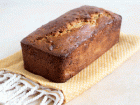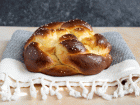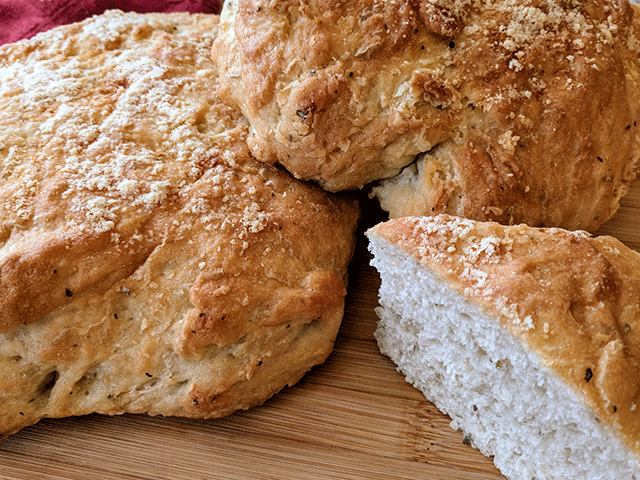
Looking back, I’ve realized that the past few years have been a fun experiment in bread making. I tried a lot of bread recipes, and I was happy with what I learned. I enjoyed a variety of flavors from sweet to savory to sour, and I figured out how to make decent bread without burning it.
No-knead peasant bread was the first bread recipe that I’ve ever successfully made, and it was the first one that made me excited about baking. I loved the flavor and the texture, and I loved that I could make it in a reasonable amount of time with little effort on my part.
With some experimenting, I discovered that peasant bread worked well with three new flavors: rosemary garlic, Parmesan oregano, and Italian herb. Give these peasant bread varieties a try if you’re in a baking rut.
Original Recipe
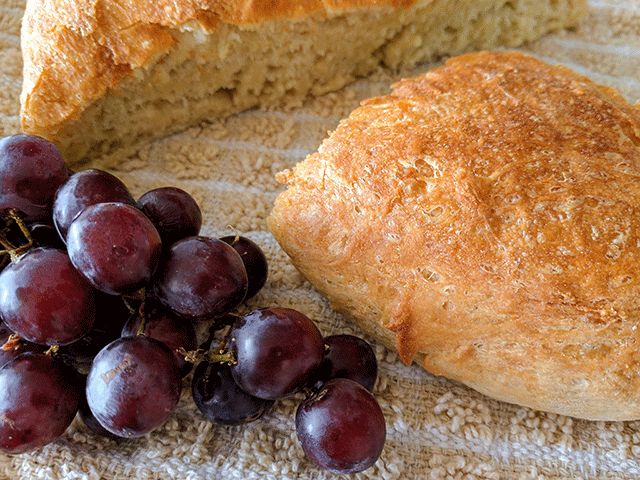
In case you missed my original peasant bread recipe, I’ll save you the click and provide the basics here.
Ingredients
- 8 Grams (2 ¼ Teaspoons) Dry Active Yeast (1 Packet)
- 12 Grams (1 Tablespoon) White Granulated Sugar
- 12 Grams (2 Teaspoons) Table Salt
- 473 Grams (2 Cups) Warm Water
- 480 Grams (4 Cups) All Purpose Flour
Additional Equipment
You’ll want to have these items on hand when you make the bread:
- Large Mixing Bowl
- Wooden Mixing Spoon
- Measuring Cups and Spoons
- Baking Sheet
- Silicon Cooking Brush
- Cooling Rack
You’ll probably have these items in your kitchen already. But if you don’t, I’ve linked you to a few good ones on Amazon. As an Amazon associate, I do earn a small commission on qualified purchases, but I only recommend products I use and enjoy regularly.
Instructions
Here’s a quick rundown of what you need to do:
- In a large bowl, stir yeast, sugar, and salt in the warm water until all grains dissolve.
- Add flour and stir until well incorporated.
- Cover and let rise until double in size (about 1 hour).
- Tip dough onto lightly greased and floured baking sheet. Divide dough and loosely shape into two rounds.
- Let dough rest for 1 hour.
- Brush with melted butter.
- Preheat oven to 425 degrees Fahrenheit (218 degrees Celsius) and bake for 10 minutes.
- Reduce heat to 375 degrees Fahrenheit (190 degrees Celsius) and bake for another 15 to 20 minutes.
For concision’s sake, I won’t provide step-by-step pictures of the baking process or secrets to success. If you want more details about the original recipe, check out the no-knead peasant bread here.
Now that you have the basics, let’s move onto the three different peasant bread varieties.
Rosemary Garlic
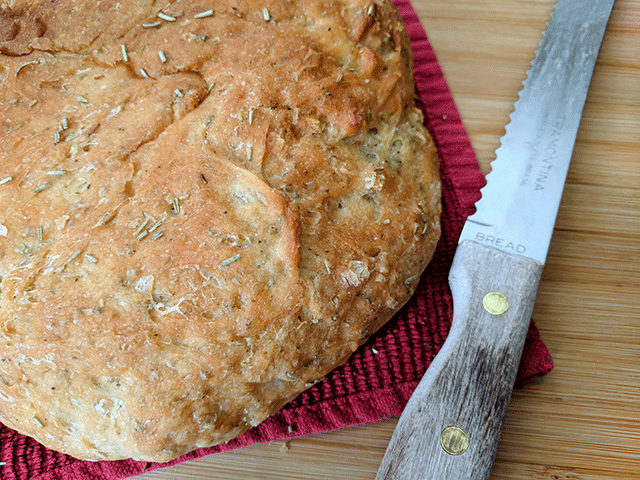
Let’s take the flavor up a notch with this rosemary garlic peasant bread. It has all the simplicity of regular peasant bread but with a few fun extras.
I paired this bread with a classic slow cooker chicken noodle soup (which also featured rosemary and garlic), and it tasted like a match made in heaven. You can also try dipping this bread in olive oil or marinara sauce.
Of the three peasant bread varieties, this is the one I make whenever I have Italian food in mind.
Additional Ingredients
In addition to all the above ingredients for peasant bread, you’ll need these for rosemary garlic peasant bread:
- 3 Grams (2 Tablespoons) Dried Rosemary
- 1 Gram (1/2 Teaspoon) Ground Pepper
- 1 Gram (1 Teaspoon) Oregano
- 6 Grams (2 Teaspoons) Minced Garlic
Just a few extra seasonings and you’re ready to go!
Instructions
Rosemary garlic peasant bread varies a little in the beginning, but it rises and bakes like the original recipe:
- In a small bowl, stir yeast, sugar, and in the warm water until all grains dissolve.
- In a large bowl, stir flour, salt, rosemary, pepper, and oregano together.
- Combine yeast mixture with flour and stir in the minced garlic until everything is incorporated.
- Follow steps 3 through 8 in the original recipe.
If you wish, feel free to sprinkle a little extra rosemary on top after you brush your bread with butter. It adds to the flavor and gives your bread a more polished appearance.
Parmesan Oregano
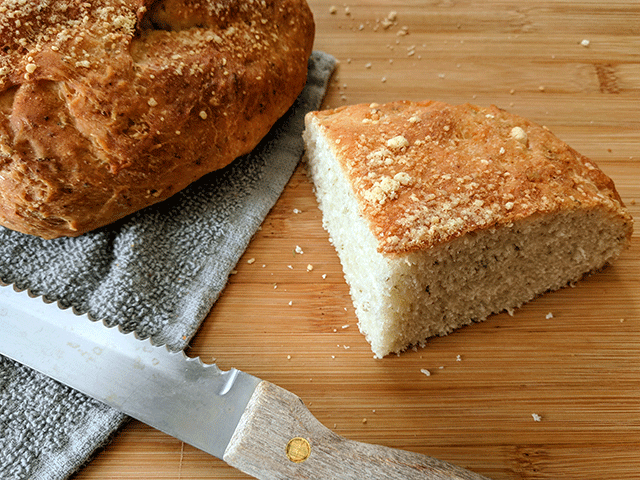
This is by far my favorite of the three peasant bread varieties. It’s easy. It’s tasty. And it pairs well with pasta, though it definitely stands well on its own, too. I’m honestly not sure I want to go back to the original peasant bread after sampling parmesan oregano peasant bread.
I think the parmesan cheese gives this loaf a flavorful kick that doesn’t compare to anything else.
Additional Ingredients
Here’s what you’ll need for the bread:
- 90 Grams (1/3 Cup) Grated Parmesan Cheese
- 4 Grams (1 Tablespoon and 1 Teaspoon) Oregano
You’ll also want a little extra parmesan for sprinkling.
Instructions
Not too many variations with this bread here. Still as easy to finish as ever!
- In a small bowl, stir yeast, sugar, and in the warm water until all grains dissolve.
- In a large bowl, stir flour, salt, parmesan cheese, and oregano together.
- Combine yeast mixture with flour and stir until everything is incorporated.
- Follow steps 3 through 8 in the original recipe.
Don’t forget to sprinkle a little more parmesan on top of your bread after you’ve brushed it with butter. The extra pinch really helps the parmesan flavor come through, and it adds a nice texture when you bite into it.
Italian Herb
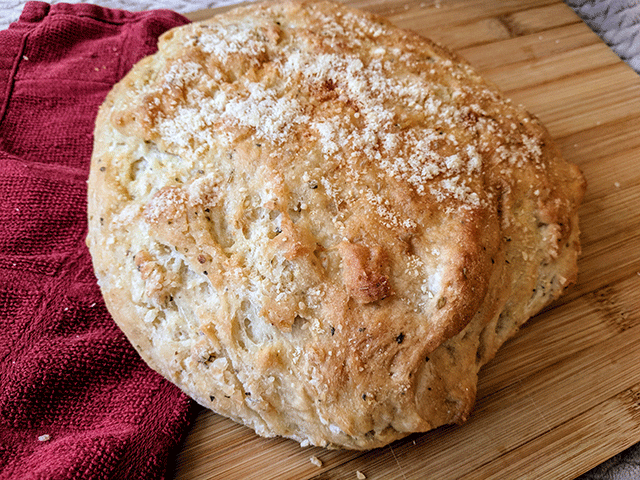
Italian Herb combines the flavors of the other two peasant bread varieties and, as a result, has a more complex flavor than the other two recipes. It stands well on its own or with pasta. I could not get enough of the smell as I pulled it out of the oven.
Additional Ingredients
Don’t forget these key ingredients:
- 0.7 Grams (1/2 Teaspoon) Basil
- 0.5 Grams (1/2 Teaspoon) Oregano
- 0.3 Grams (1/2 Teaspoon) Marjoram
- 0.5 Grams (1/2 Teaspoon) Rosemary
- 1 Gram (1/2 Teaspoon) Garlic Powder
And, of course, you’ll want all the ingredients in the original recipe, too.
Instructions
With just a small change in the original recipe, you can enjoy sun-dried tomato and basil peasant bread in a flash:
- In a small bowl, stir yeast, sugar, and in the warm water until all grains dissolve.
- In a large bowl, stir flour, salt, basil, oregano, marjoram, thyme, and garlic powder together.
- Combine yeast mixture with flour and stir until everything is incorporated.
- Follow steps 3 through 8 in the original recipe.
If you want, sprinkle a little parmesan on top of your bread after you’ve brushed the top with butter.
Did You Try Them?
My husband and I can’t seem to get enough of easy, fast bread, so these peasant bread varieties are a great way to switch things up and still satisfy those cravings. I’d love to hear about your bread adventures, though. Did you like these new flavors? Do you have your own variation that you want others to know about? Share your thoughts, comments, and ideas below.

